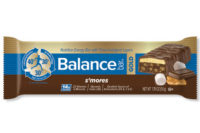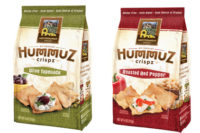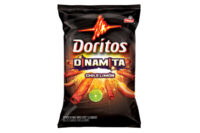Pork rinds are probably the most misunderstood item in the snack category. This is surprising, because people have been eating pork rinds—also called pork skins—as long as they have been eating pigs. One of the world’s first snack foods created thousands of years ago, and favored in the southern states, pork rinds are a simple combination of fried pork skins and salt.
Despite the snack’s simplicity, it has to have variety, according to consumers of these items. Whether it’s the format or flavor of the product, manufacturers must keep on their toes, putting innovation on the high beam.
“We are seeing an increase in sales with our products,” says Reta W. Johnson, owner of Julia’s Pantry, a producer of pork skin products in Raleigh, N.C. “[Due to innovations], we’re winning back some folks who gave up this snack in the past.”
According to SymphonyIRI Group, a Chicago-based market research firm, in the 52 weeks ending April 15, 2012, dollar sales of pork rinds in U.S. supermarkets, drugstores, convenience stores and mass market retail locations, excluding Walmart, totaled almost $261 million. This showed an increase of close to 4.5% from the prior year. Unit sales were virtually flat, rising just 1.25 during this time period.
“The category overall is similar to the snack food category as a whole, which is relatively soft with the economy,” states Mark Singleton, vice president of sales and marketing at Rudolph Foods, a Lima, Ohio, pork rind producer for 57 years. “When gas prices spike, fewer people visit convenience stores and this impacts sales.”
Pork rind manufacturers continue to educate consumers about their offerings, which typically contain no trans-fat. “In some parts of the country that were a tougher sell, we’re seeing a resurgence of these snacks,” Singleton says. “For example, the biggest growth is in the northeastern states. Convenience stores are driving these sales.”
In the past decade, there has been much innovation in the pork rind category. Interest peaked with the growing popularity of the protein-laden, low-carb Atkins diet in the ’90s. “There are still a lot of folks interested in low-carb diets as well as comfort foods and snacks that remind them of their childhood,” says Angela Jacobs, president of Carolina Country Snacks, Henderson, N.C. “Even though our pork rind sales have leveled off, we attribute this to the decrease in disposable income.”
Although the demographic profile of pork rind consumers is more urban and southern, the popularity of these snacks is expanding. “These items have no carbs, so they appeal to diet-conscious consumers,” says Eugene Wallace, co-owner and vice president of sales at Wallace’s Old Fashioned Skins in Florence, S.C.
Hogwild configurations
Since Wallace’s began manufacturing pork skin products in 1977, its business and product offerings have grown to include a host of hog varieties. “In 1980, we were one of the first companies to develop wash pot cracklins, a pork skin variety that is very hard and crunchy,” Wallace says.
The company also offers fatback pork skin snacks, which are similar to the fatback southern delicacy consisting of fried pork skin with meat attached. This side dish is typically consumed as a substitute to bacon in breakfast dishes.
“The processing of our fatback snacks is similar to the traditional method,” Wallace says. “We process it so the grease is cooked out and it’s dry. The fatback variety is shaped differently than the cracklins.”
Wallace’s produces different pork skin formats. In addition to cracklins and fatback types, there are pork strips, which are a crunchy skin with no meat attached, and curls. Some of these snacks have healthier profiles than others. For example, cracklins are higher in fat than traditional pork skins, which are more light and fluffy in texture.
Carolina Country Snacks offers a variety of pork skin snacks, including the puffy and traditional pork rinds and crackling fat backs. “Old Time Fat Backs are our top seller and taste like homemade snacks from a frying pan,” Jacobs says. “We just debuted our barbecue flavor. We also have hard, seasoned strips of pork skin that are popular.”
Turkey Creek Snacks, a pork rind producer in Thomaston, Ga., offers strip cracklins, a big seller. “They are a different cut than traditional pork rinds, but use the same seasoning,” says Laddie Fulcher, owner of the company.
Rudolph Foods recently debuted Dippers, which are cut and cooked differently than traditional pork rinds. “This product has a unique texture and mouthfeel that is different than traditional pork skin products,” Singleton says. “We also have a new line, Colossal, which is doing well. It’s important to continue to innovate.”
Flavorful contenders
Like other snack food categories, pork rinks have unique flavors that are helping to vie for more sales in the segment. Hot-and-spicy varieties are the most prevalent, followed by flavors that mimic the potato chip category.
“People in the Southeast love spicy snacks,” Wallace says. “The most popular seasonings for pork rinds are cayenne, jalapeno and red, white and black pepper.” In addition to regular and barbecue flavors, Wallace’s offers a hot-and-spicy variety that includes a mixture of red and black pepper. The company’s combination flavors, including salt and vinegar, as well as a salsa and sour cream, have garnered much attention in this category.
Fulcher agrees that hot-and-spicy varieties are helping to grow the pork rind segment. “People looking for snacks generally want something salty,” he says.
The pork rind industry, as a whole, has focused on adding innovative flavors that appeal to a growing number of consumers. For example, Rudolph Foods has created a habanero and lime pork rind variety that is a top-selling, stock-keeping unit in California. “This flavor profile speaks to Hispanic consumers, a growing demographic that bodes well for the category overall,” Singleton says. The company conducted a number of focus groups recently to determine what Hispanic consumers were looking for.
“We discovered that pork rinds with liquid hot sauce are very popular, so we launched a new line that includes a hot sauce packet,” Singleton adds. “We expect it to take off with Hispanic consumers as well as other demographics.”
New flag wavers
Along with changing formats and unique flavors, manufacturers have been developing a number of innovations in the pork rind category. One of the recent flag wavers is microwavable pork rinds, which are being positioned as a healthier snack alternative. This snack type incorporates a different production method.
While both pork rind types start with a pellet, traditional varieties are cooked in rendered pork fat, absorbing about 25% of the grease. These are produced in high volume using large cookers.
With the microwavable variety, the pork pellet is sold uncooked. Consumers prepare it by placing it on a plate and cooking it the microwave, similar to preparing popcorn. “There are more microwavable products on the market now,” Jacobs says. “This is a healthier alternative, since the process uses air instead of lard.”
Julia’s Pantry is offering microwave pork rinds as an extension of its traditional line. These snacks have 60% less fat and 33% less sodium than regular pork rinds. Each one-cup serving offers 9 g. of protein. “This new product appeals to a lot of folks who had to give up the traditional snack due to health concerns,” Johnson says. “For those dealing with weight-loss issues, hypertension or high blood pressure, these products are a healthier alternative that taste good.”
There have been changes in packaging that mimic other snack categories, too. Julia’s Pantry sells its pork rind lines in resealable Mylar bags. “Consumers can determine how many or few to eat at a time,” Johnson says. “These products have a nine-month shelf life, compared with cooked pork rinds, which offer a three- to four-month shelf life.”
The company’s microwavable line is sold in 2-oz. bags that produce four cups of puffed pork rinds. The product also is sold in 8-oz. and 1- and 5-lb. bags.
Sustainability has been the focus when it comes to packaging, with some companies developing petroleum-free-based bags. “With pork skins, there are many sharp edges, so manufacturers have to be careful that the packaging material can withstand this,” Wallace points out.
Rudolph Foods has created 10.5-oz. barrels to merchandise its product lines, which have been well-received.
Interest in low-sodium pork rinds is also high on the consumer preference list. “If these products don’t have an adequate amount of salt, they don’t taste good, so no one has expanded on this yet,” Wallace says.
Restaurant exposure
In addition, what has given the pork rind segment even more exposure is the adoption of these products at high-end restaurants, such as The Publican in Chicago and Smoke Restaurant in Dallas. “We’re seeing a return to comfort foods,” Singleton says. “Pork rinds are very popular in the South and in the Hispanic culture, but when we’re getting these items into a venue, it’s a real opportunity to drive trial and get people interested in these snacks.”
There is still much potential for these products at the retail level. “As we look at ways to grow our business, we remain convinced that, at less than 20% penetration at the household level, there is a lot of untapped potential,” Singleton notes. “It’s a matter of getting our story out there.”
Companies like Rudolph Foods are conducting sampling events at state fairs and barbecue festivals with the purpose of driving trial and consumer awareness. “This is a multimillion dollar business, and a snack that has been around forever,” Johnson says. “[Due to new innovations and products], the category is winning back some consumers who gave it up as a snack.”
There are still pockets in America that are under-represented with these products.
“There are no stores that can’t take advantage of the opportunity to grow this category,” Singleton says. “Given the number of facings and flavors that appeal to core consumers, we can justify pork rinds’ place in stores and grow sales year after year.”






